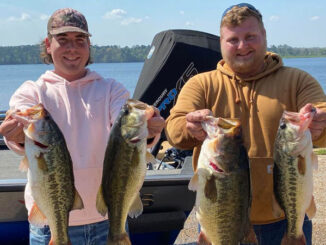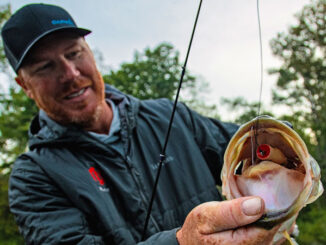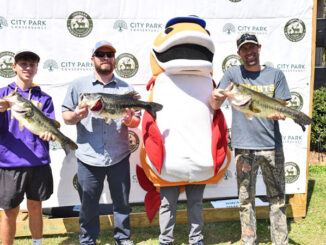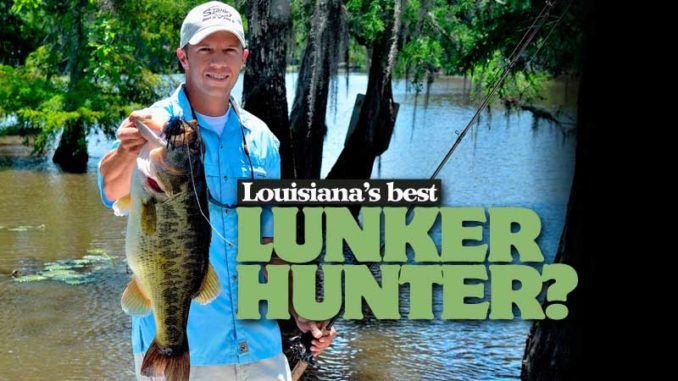
Johnny Watkins of Longville has taken a treasure trove of huge largemouth bass in southwestern Louisiana’s rivers and reservoirs. Could he be the best around?
No doubt, Louisiana Sportsman readers have viewed multiple stories about Toledo Bend reservoir, the famous lunker-rich pools of Lacassine National Wildlife Refuge and other bass hotspots in southwestern Louisiana.
In many of these articles, Longville’s Johnny Watkins has been featured, and in most cases, he is pictured holding one or more double-digit largemouths.
When recently asked about the number of bona fide Louisiana lunkers he has taken, Watkins, a 42-year-old captain in the Lake Charles fire department, was a bit hesitant.
Watkins is well-known among bass fishermen in the area as not being much of a braggart. In fact, he shares much of what he has learned about catching monster bass with just about anyone who asks.
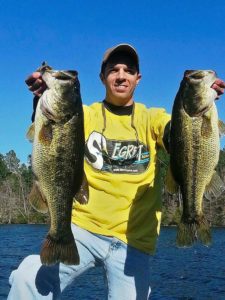
When Watkins finally had the number of lunkers he’s taken wrangled from him, his listing makes an argument that this humble, friendly fireman and beloved family man may indeed be one of the best lunker bass anglers in Louisiana — if not the very best.
“That boy has always had a gift at catching big fish,” said Steven Stroderd of Carlyss, a noted trophy speckled trout specialist in the area. “As long as I have ever fished with him in saltwater and freshwater, he’d catch a big one.”
A very impressive fishing record
Watkins has taken these huge bass: four 11-pounders; 21 10-pounders; more than 30 weighing 9 pounds or better, and at least 50 between 8 and 9 pounds.
And all these brute fish were taken in Louisiana waters to which any angler has access.
Asked about his secrets, strategies and patterns for catching so many impressive largemouths, the first words out of his mouth were to give credit where it was due.
“I met Mike Guinn of Lake Charles when I was fishing tournaments in the past, many of them dogfights on Sabine, Calcasieu and the Lacassine pools,” Watkins said. “He helped teach me how to mentally target big bass, and his instruction helped fuel a passion in me that has grown ever since.”
According to Watkins, Guinn taught him to mentally dissect a body of water and how to think about staying in a position to catch bigger fish.
Another angler that Watkins has spent much of his time fishing tournaments with is Bart Blakelock, formerly of Lake Charles and now living in Waelder, Texas.
“Bart and I fished many tournaments together in the past, and with so much time spent together, we really learned from each other,” he said. “We had a very memorable win on Toledo Bend in 2014 with 30.8 pounds of fish when fishing a Bass N Bucks event. The very first piece of advice I offer anglers is to simply find locations to fish where the big bass are.”
Toledo Bend
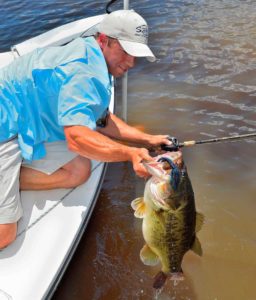
No doubt, Toledo Bend has produced many double-digit lunkers over the years, and Watkins has scored on two of them. Only one was registered with the Toledo Bend Lunker Bass Program: a 10.28-pounder taken in March 2016. The other was a 10.0-pound bass that he immediately released after taking a few photos. He has also taken many 9s and 8s in Toledo Bend over the years.
His most memorable Toledo Bend trip was with his wife, Sara, and sons Kade and Garrett on Mother’s Day 2013. Sara landed an 8-pounder on a Stanley Top Toad, and Watkins caught a 9-pounder on the same lure a little later.
“A notion I learned when finding big bass is that it’s all in the details,” Watkins said. “All bass need nearby food and cover, yet I find big bass also need proximity to deep water.”
Watkins knows full well the problems at Toledo Bend: the absence of submerged grasses such as hydrilla. But there is other submerged structure situated just offshore that has provided many anglers in the know with hefty largemouths.
Even during the spawning months of March and April, Watkins advises anglers to spend a good bit of time fishing away from the shallow, spawning flats. During the spawn, Toledo Bend’s bass cycle in and out of the shallows and relate to structure just offshore — once before heading to shallow-water beds and again upon returning to deeper waters after spawning.
What he uses
Watkins relies on his Humminbird Helix unit, which is critical for finding offshore structure and bass. Housen is one example of a location offering opportunities to fish submerged creeks and ledges where they intersect with wood structure such as the remnants of timber.
“In these areas, I will often cast ¾-ounce Stanley’s Stand Up jigs in black/blue/firetip with Hale Lure plastic trailers such as the Sidetrac Shad in natural colors: gizzard shad and bluegill,” said Watkins, who will also throw the 1-ounce Stanley Big Nasty jig in the same colors and with the same trailers. He may also work a Carolina rig with a Sidetrac Shad in the same colors.
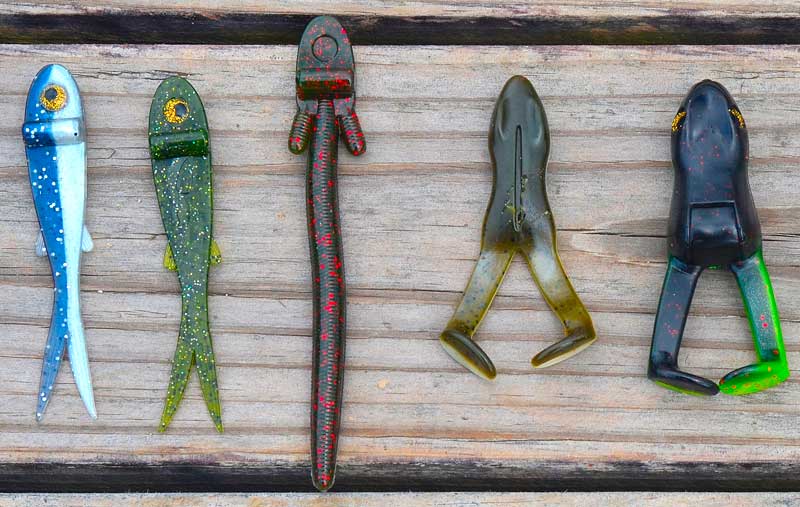
“I love the way the Sidetrac Shads can be worked to glide exactly like an injured baitfish,” he said.
Other lures Watkins works along deeper ledges with timber are Strike King’s 6XD and 8XD crankbaits in barfish color.
“I find that bass especially hit these lures as they are deflected off the stumps,” said Watkins, who also enjoys running spinnerbaits in Toledo Bend’s shallow and deep water — but chooses to use one quite large and heavy.
“The lake gets quite a bit of pressure, especially the areas that are noted to hold big bass,” he said. “I find that I often have to fish differently than many other anglers, and I have taken quality fish on a 1-ounce, white Stanley Big Shot spinnerbait with tandem gold and silver willow-leaf blades. I’ll fish them 2 to 6 feet deep.”
Lacassine NWR Pools
It is no secret the majority of Watkins’ double-digit largemouths and other hefty lunkers were taken in the pools of Lacassine National Wildlife Refuge. Here, he has scored on his largest lunkers taken — four weighing 11 pounds and better.
The pools consist of 16,614 surface acres of grassy waters, part of the refuge’s 34,866 acres near Lake Arthur.
A multitude of lunkers from 8 to 12 pounds have been taken there since the 1990s, the current Lacassine record bass, being a 13-pound, 2-ounce fish taken in March 2013 by Luke Bouillon of Grand Lake.
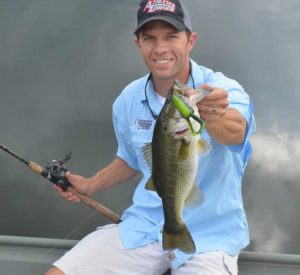
The Lacassine pools are open for fishing from March 15 to Oct. 15. In the pools, only boats with motors 40 HP or less may be used. In Lacassine Unit D, however, small, only non-motorized craft with or without electric motors are permitted; they can be launched by hand from Tidewater Road.
Boats are allowed in the refuge from one hour before sunrise until one hour after sunset. Fishing activities, however, begin at sunrise and end at sunset.
Good news
Sean Kinney, a fisheries biologist with the Louisiana Department of Wildlife and Fisheries, has very good news for anglers seeking trophy bass.
“Our sampling in 2019 showed the Lacassine pools with the following genetic percentages: pure Florida, 34.6%; and Florida-native hybrids, 42.2%,” he said.
By comparison, overall Florida genetics appeared in only 34.5% of Toledo Bend bass in 2019.
“As a result, we haven’t stocked Lacassine in several years,” Kinney said. “It is important for anglers to understand that we don’t stock for numbers throughout the state. We stock to influence the genetics of our bass to increase their size.”
Kinney had a bit of bad news about the pools; there are efforts underway combating apple snails in one of the pools.
“We also have way more aquatic vegetation in the pools than what is ideal,” he said. “As a result, we have less spawning habitat and a problem with bass reproduction.
“We can’t draw the pools down because they are shallow, and our recent winters have been mild. (Baitfish) production is also lowered, and our larger 8- to 10-pound fish are healthy, but our smaller bass are not.”
Kinney strongly advises anglers to take smaller bass out to assist with efforts to increase the health of the pools’ largemouths.
Fishing the pools
Watkins has serious advice for bass anglers fishing the pools.
“I will spend more time fishing the deeper pools; these include South Pond, Little North Lake and North Lake,” he said. “And very often even in the heat of the summer, I will push-pole my small boat in these pools, as I find that the larger bass are very wary due to the noise of motors and all the clear, shallow waters in the pools. It’s very hard, grueling work, but the rewards of bigger bass are certainly worth it.”
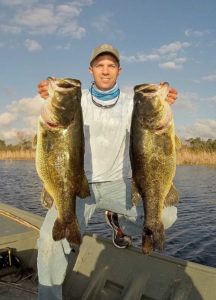
Watkins concentrates on areas with multiple kinds of structure; he finds they are magnets for larger bass.
“I will look closely at an isolated piece of cover, a few lily pads, as opposed to a 300-yard stretch of lily pads,” he said. “And when these small pieces of cover are near slightly deeper depressions, usually that’s where the big ones may spawn or just hang around. A third piece of structure such as a small vegetation mat floating nearby makes (that) area a sweet spot for lunkers.”
In these areas, Watkins will throw soft plastics, including Stanley Ribbits and Top Toads in natural colors: black/red flake (Ribbits) and watermelon red pearl (Top Toads). He will cast and work them on the surface using a rod with backbone: a heavy action 7-footer with green, 65-pound PowerPro braid spooled on a 7:1 fast Curado reel.
Bedding bass
When fishing for bedding bass in the pools, Watkins will tinker with his Top Toad, plugging up its back side so when it reaches the bed, it stands vertically, a presentation he said infuriates bedding lunkers. All of his Top Toads carry Stanley’s Double-Take hooks.
When not fishing for bedding bass, Watkins will punch through vegetation with a Sidetrac Shad in natural colors: bluegill and gizzard shad. He raves about the ability of anglers to control the left or right movement of the Sidetrac Shad, especially to get the lure under vegetation mats and lily pads.
“When it’s windy, I will often cast spinnerbaits,” he said. “If you can find clusters of five to six lily pads, these are choice places to cast spinnerbaits, as bass will often ambush baitfish from these locations.”
When fishing spinnerbaits, Watkins prefers natural colors, using a ¼-ounce CW Custom Baits bluegill spinnerbait sporting a single, copper willow-leaf blade.
“It’s very difficult to work spinnerbaits with more than one blade in all the vegetation,” he said.
In the deeper, ring canals, Watkins will fish Sidetrac Shads and spinnerbaits along the edges of the perimeter.
“On the outside edges of the canal, where it starts to drop off — that’s when I usually get strikes,” he said. “I find smaller fish in the canal, but every now and then you can catch a 6- or 7-pounder.”
Watkins is very careful when handling lunker largemouths everywhere he has taken them. He believes that such fish are precious, and he most always practices catch-and-release.
Fishing information, rules and maps of Lacassine NWR can be downloaded at https://www.fws.gov/southeast/pdf/regulations/lacassine-national-wildlife-refuge-fish.pdf

